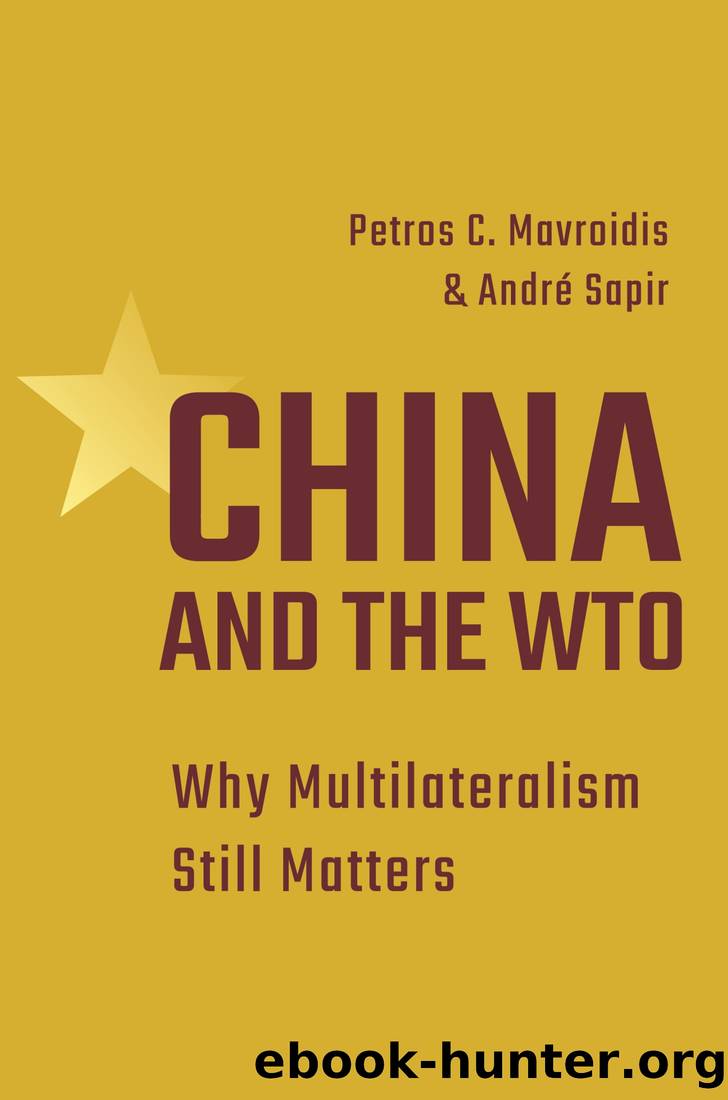China and the WTO by Petros C. Mavroidis

Author:Petros C. Mavroidis [Mavroidis, Petros C.]
Language: eng
Format: epub
ISBN: 9780691206592
Publisher: PrincetonUP
Published: 2020-10-28T00:00:00+00:00
Japan Inc. became Japanâs de facto name in trade circles. Through this sobriquet (or nom de guerre, depending on the perspective), its trading partners wanted to denote that private agents played second fiddle to idiosyncratic (if not whimsical, echoing folie de grandeur) aspirations of the Japanese government to dominate international economic relations. Japanâs trading partners adopted both multilateral and bilateral measures to try to change Japanâs practices.
Multilateral Measures
The United States, Canada, and the EU litigated what was allowed under the GATT multilateral rules. Japan was a defendant in nine cases that reached formal adjudication between the time of its accession in 1955 and 1994, before the advent of the WTO. The cases (listed in chronological order) are: JapanâSilk Yarn (United States, 10/25/1977), JapanâLeather I (US) (United States, 7/19/1978), JapanâLeather (Canada) (Canada, 10/26/1979), JapanâTobacco (United States, 11/7/1979), JapanâLeather II (US) (United States, 2/24/1983), JapanâAgricultural Products (United States, 8/12/1986), JapanâAlcoholic Beverages (European Community, 10/31/1986), JapanâSemi-Conductors (European Community, 2/19/1987), and JapanâSPF Dimension Lumber (Canada, 3/19/1988).44 Japan prevailed only once (SPF Dimension Lumber) and implemented all reports where its measures were found to be inconsistent with the GATT. Actually, it formally adopted only six reports, since twice (in Silk Yarn and Tobacco) it settled with the complainant (the United States) before the report was issued. The two instances where Japan settled concerned state-trading enterprises having a monopoly over the import of silk yarn and tobacco. Note also that seven of the eight cases lost by Japan concerned its import regime. The other case concerned its export prices for semiconductors, where the European Community (EC), as the European Union was then called, acted as complainant.
The complaints about Japan, as is the case with complaints against China, also demonstrated the limits of what can be done against countries with heavy state involvement in the economy within the four corners of the world trading regime. In a communication to the GATT membership in 1983, the EC complained about what it viewed as âa serious problem: the difficulty of penetrating the Japanese market.â It requested the establishment of a Working Party under Article XXIII:2 of the GATT (Nullification and Impairment), on the basis that âbenefits of successive GATT negotiations with Japan have not been realized owing to a series of factors peculiar to the Japanese economy which have resulted in a lower level of imports, especially of manufactured products, as compared with other industrial countries.â45 While acknowledging that Japan had recently taken some measures to alleviate the situation, the EC noted that âthe impact of these measures as a whole is limited and not commensurate with the magnitude of the problem.â Consequently, the EC demanded
a solution ⦠which requires a co-ordinated series of general and specific measures, which go beyond the formal barriers at the border, and which are designed to bring about a definitive and substantial improvement in the present situation. In this context, the European Community reiterates that it is not seeking a fundamental change in the Japanese socio-economic system. It is interested in results: a
Download
This site does not store any files on its server. We only index and link to content provided by other sites. Please contact the content providers to delete copyright contents if any and email us, we'll remove relevant links or contents immediately.
| Anthropology | Archaeology |
| Philosophy | Politics & Government |
| Social Sciences | Sociology |
| Women's Studies |
Cecilia; Or, Memoirs of an Heiress — Volume 1 by Fanny Burney(31322)
Cecilia; Or, Memoirs of an Heiress — Volume 3 by Fanny Burney(30928)
Cecilia; Or, Memoirs of an Heiress — Volume 2 by Fanny Burney(30885)
The Great Music City by Andrea Baker(21195)
We're Going to Need More Wine by Gabrielle Union(18064)
Bombshells: Glamour Girls of a Lifetime by Sullivan Steve(13100)
Pimp by Iceberg Slim(12922)
All the Missing Girls by Megan Miranda(12739)
Fifty Shades Freed by E L James(12443)
Norse Mythology by Gaiman Neil(11873)
Talking to Strangers by Malcolm Gladwell(11861)
Crazy Rich Asians by Kevin Kwan(8340)
Mindhunter: Inside the FBI's Elite Serial Crime Unit by John E. Douglas & Mark Olshaker(7827)
The Lost Art of Listening by Michael P. Nichols(6462)
Enlightenment Now: The Case for Reason, Science, Humanism, and Progress by Steven Pinker(6402)
Bad Blood by John Carreyrou(5761)
The Four Agreements by Don Miguel Ruiz(5502)
Weapons of Math Destruction by Cathy O'Neil(5029)
We Need to Talk by Celeste Headlee(4861)
